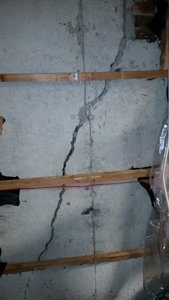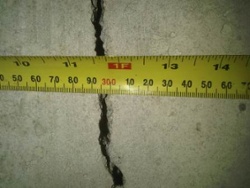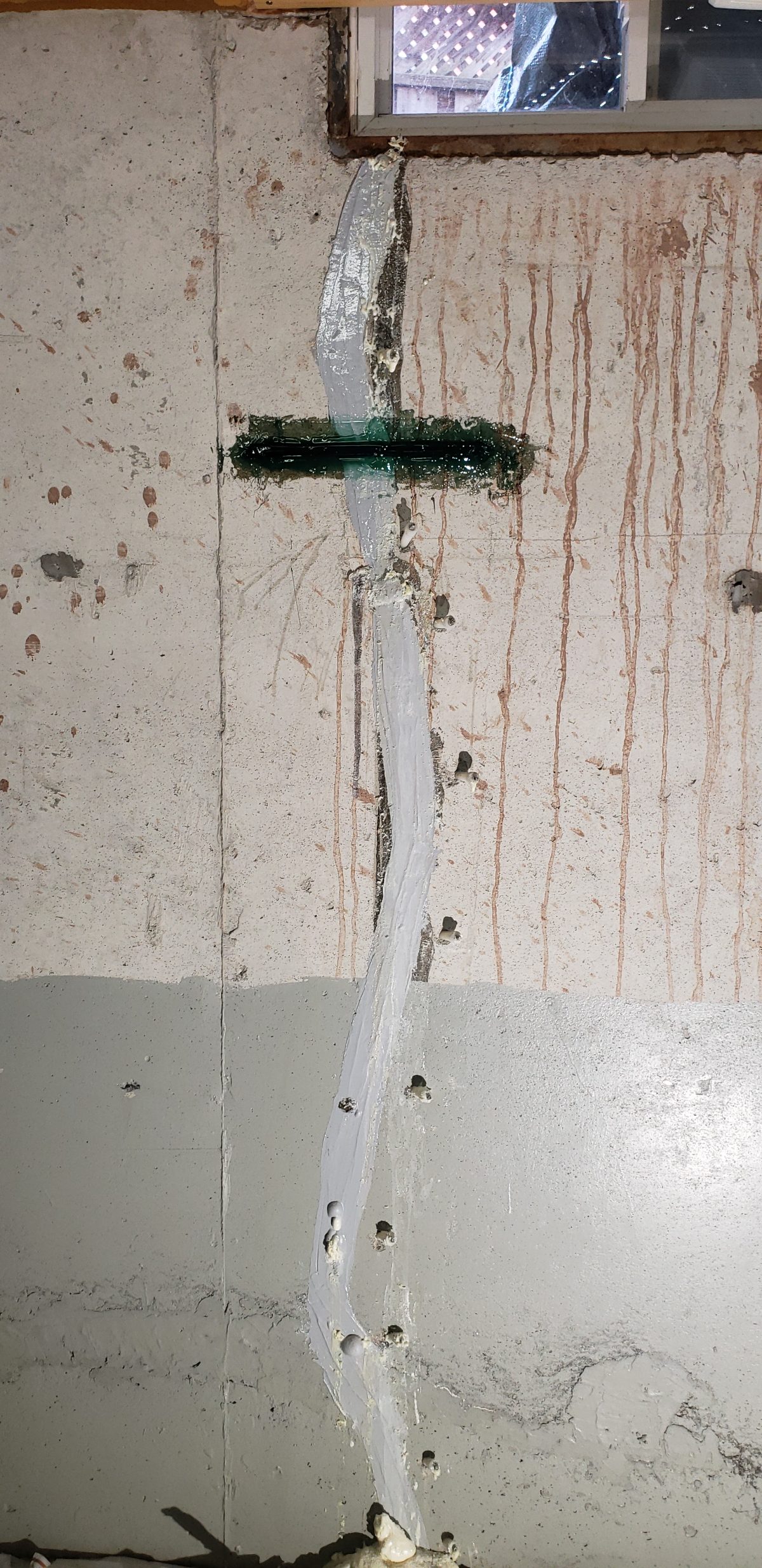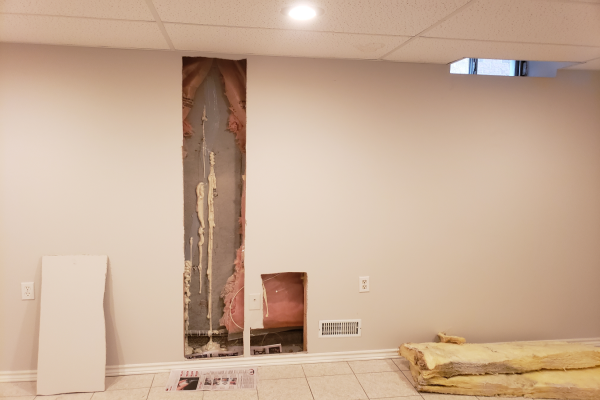This article on foundation concrete crack repair discusses typical foundation crack repairs for both poured concrete and concrete block foundations.
Contents
Repairs For Poured Concrete Cracks and Related Issues
Common Concrete Crack Repairs
Concrete block/ Cinderblock Foundation Crack Repair
Repairs For Cracked Concrete Blocks and Related Issues
In order to comprehensively discuss concrete crack repair, the objective of the repair and the foundation type are the two most critical factors that dictate how a crack repair should be undertaken. For poured concrete foundations (most homes built from 1980 onwards) there are essentially two types of crack repairs: waterstopping, and structural repairs.
With respect to concrete block / cinder-block foundations, the repair options are very different from those applicable to poured concrete foundations; typical crack repairs for concrete block / cinder block foundations are: tuck pointing, structural reinforcement, waterproofing, parging and the repair of cracks present in the blocks themselves.
Repairs For Poured Concrete Cracks and Related Issues
In general, crack repairs in poured concrete, in both residential and commercial applications, are undertaken to stop basement leaks or groundwater leaking through structures such as parking garage ceilings, walls and joints between two concrete structures. Occasionally, parging of the exterior foundation walls is done to ensure that the foundation has a uniform appearance or to conceal exterior cracks visible during an inspection.
For information specifically pertaining to poured concrete foundation waterproofing, follow the link: Poured concrete foundation waterproofing; the same article is equally relevant to many commercial applications. From time to time, larger cracks, deemed to be structural in nature, which may or may not actively leak, will require structural repair and/or reinforcement.
Waterstopping (preventing water from entering your basement through a crack or some other point of entry through a foundation wall) can be accomplished by polyurethane crack injection, and/or epoxy crack injection, as well as external crack repair.
Common Concrete Crack Repairs
Below is a list of the most common concrete and/or crack repairs and the associated repair methods:
- Actively leaking cracks in a foundation or other concrete structure – polyurethane crack injection or external crack repair. (Hydraulic cement is to be used on the interior side of the foundation wall only in the event of an emergency).
- Cracks that leak occasionally or not at all – polyurethane or epoxy crack injection or external crack repair.
- Wide cracks (> 3mm) – polyurethane crack injection with reinforcement or epoxy crack injection possibly with reinforcement (if reinforcement is recommended by the Injection Technician). External crack repairs are not recommended as little would be gained by not repairing the crack through the entire wall thickness (typically 20cm or 8″).
- Spalling on the surface of an exterior foundation wall (chipping and crumbling of the wall surface) – this is technically a masonry repair involving a surface coating to replace the missing concrete, and parging to provide a uniform appearance of the concrete wall surface.
- Flaking of a parge coat on an exterior wall surface – another type of masonry repair involving the wire brushing of the wall surface to remove existing parging with poor adhesion, and the re-parging of the wall to provide a uniform appearance of the concrete wall surface.
These are not common foundation cracks – they require special attention

A very wide crack in a poured concrete foundation may require expensive structural repairs

Sometimes the crack needs to be closed before waterproofing can be done
Concrete block / Cinder-block Foundation Concrete Crack Repair
The repair of cracks in concrete block (or cinder-block) walls and/or foundations is accomplished using methods which are different from those used for repairing cracks in poured concrete foundations. This dissimilarity is attributable to the differences in the materials and characteristics of the two foundation types.
Concrete block foundation crack repairs are typically undertaken to address basement leaks and to address concerns pertaining to the structural integrity of the foundation wall(s).
Most of the cracking in a concrete block / cinder-block wall is typically found in the mortar joints between the blocks; this cracking occurs due to the different rates of thermally induced expansion and contraction of two dissimilar materials, the mortar between the blocks and the concrete blocks themselves. The repair of such mortar joint cracking is accomplished using a process referred to as tuck pointing or re-pointing (this is the domain of masons). Tuck pointing involves the removal of the damaged or deteriorated mortar between the concrete blocks and the replacement of the old mortar with new mortar. Tuck pointing must be accomplished from the exterior side of a foundation wall if the objective is to prevent water ingress through mortar joints. Similarly, cracked blocks must also be repaired on the exterior side of a wall in order to prevent water ingress and to ensure that water does not penetrate the blocks via any cracking; this is particularly important when the cracked blocks and/or mortar joints are exposed to freezing temperatures. In Southern Ontario, the frost line in the winter will typically be as deep as 3.5′ below the surface.
While tuck pointing of the mortar joints, and the repair of any cracked concrete blocks, on the external side of a concrete block wall should theoretically prevent water from penetrating a concrete block wall, tuck pointing alone does not effectively waterproof this type of foundation given the common tendency of this type of foundation to re-develop mortar joint cracking due to the different rates of expansion and contraction of the dissimilar block and mortar materials. To properly address basement leak issues originating with cracked mortar joints and/or blocks, basement waterproofing is required. For greater detail concerning the external waterproofing of a concrete block foundation, visit our page on Excavation and Waterproofing.
Repairs For Cracked Concrete Blocks and Related Issues
Below is a list of the most common concrete block and/or crack repairs and the associated repair methods:
- Actively leaking foundation – Excavation and Waterproofing or Interior Weeping Tile System Installation.
- Mortar joint cracks (internal and/or external) – tuck pointing of the mortar joint(s).
- Wide cracks (> 3mm) – in this case, the cause of the wide crack must be ascertained before a suitable solution can be decided upon. Waterproofing via any method will not address the fundamental cause of the development of the crack unless the crack has grown due to water freezing within the cracks during numerous winters.
- Spalling on the surface of an exterior foundation wall (chipping and crumbling of the wall surface) – this is technically a masonry repair involving a surface coating to replace the missing concrete, and parging to provide a uniform appearance of the concrete block wall surface.
- Flaking of a parge coat on an exterior wall surface – another type of masonry repair involving the wire brushing of the wall surface to remove existing parging with poor adhesion, and the re-parging of the wall to provide a uniform appearance of the concrete wall surface.
The majority of the foundations built between 1950 and the late 1970s are concrete block. The parge coat on the exterior wall is typically just under 1cm thick; if the adhesive strength of the existing parge coat is questionable or if the parge coat has fallen off, a resurfacing of the wall is required if a presentable repair is desired.
Note: When concrete crack repairs are contemplated due to the presence of basement leaks it is imperative that the leak source(s) be positively identified. Without confirmation of the precise cause of the leak, you run the risk of paying money for the wrong repair solution. In many instances, homeowners are sold on a repair (often involving thousands of $$) that is inappropriate to the situation at hand; consequently, homeowners waste their money and the problem(s) remain.
AquaGuard Injection & Waterproofing® is committed to business integrity and professionalism; consequently, we will work with you to determine the best course of action to take based on the problem(s) you are experiencing. We guarantee that you will be satisfied in your dealings with us; read what our customers have to say about AquaGuard Injection & Waterproofing®.





